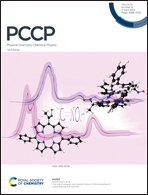Some aspects of the glass transition of polyvinylpyrrolidone depending on the molecular mass†
Abstract
Amorphous polymers currently have a wide range of applications, including the production of amorphous solid dispersions in the pharmaceutical industry. This application requires knowledge of the kinetic parameters of the glass transition process, which are the key to the formation of the end product. In the present work, we have thoroughly investigated the glass transition in the biocompatible polymer polyvinylpyrrolidone as a function of the polymer molecular mass, using differential scanning calorimetry, fast scanning calorimetry, and broadband dielectric spectroscopy. We have determined the dependence of the difference between the isobaric specific heat capacities of the liquid and the glass on the dynamic glass transition temperature, volume, and number of particles included in the cooperatively rearranging regions. A linear dependence between the shift factor from the Frenkel–Kobeko–Reiner equation and the molecular mass of polyvinylpyrrolidone was established. The results of the present work help in choosing the optimal excipient for the development of solid dispersions based on amorphous polymers.



 Please wait while we load your content...
Please wait while we load your content...